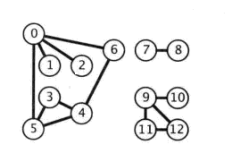表示图的数据类型
有多种数据结构可以表示图(如邻接矩阵、邻接表数组),这里探讨的是使用邻接表数组表示图。
邻接表数组:使用一个以顶点为索引的列表数组,每个数组元素为一个Bag对象,对象中存储的是所有与该顶点相邻的顶点。(Bag类似于栈Stack,只能向其中添加元素)。
如下图及其邻接表数组:


由于Graph的实现需要用到Bag,这里先了解一下Bag(背包)的基本知识。
Bag类似于栈都是用于存储数据的,与栈唯一的不同在于Bag只能添加元素。
Bag使用链表存储数据。
Bag的API如下:

Bag的实现代码如下:
import java.util.Iterator; public class Bag<Item> implements Iterable<Item>{ private class Node { Item item; Node next; } private Node first; private int N; public boolean isEmpty() {return N==0;} public int size() {return N;} public void add(Item item) { Node temp = new Node(); temp.item = item; temp.next = first; first = temp; } private class ListIterator implements Iterator<Item> { private Node current = first; @Override public boolean hasNext() { return current != null; } @Override public Item next() { Item temp = current.item; current = current.next; return temp; } } @Override public Iterator<Item> iterator() { return new ListIterator(); } // // Bag测试 // public static void main(String[] args) { // // Bag<Integer> bag = new Bag<>(); // bag.add(3); // bag.add(2); // bag.add(3); // bag.add(1); // // for (int i:bag) // System.out.println(i); // } }
Graph的API如下:

Graph的实现代码如下:
public class Graph { private final int V; private int E; private Bag<Integer>[] adj; public Graph(int V) { this.V = V; this.E = 0; adj = (Bag<Integer>[]) new Bag[V]; for (int v = 0; v<V; v++) adj[v] = new Bag<Integer>(); } /** * Return the count of vertices */ public int V() {return V;} /** * Return the count of edges */ public int E() {return E;} public void addEdge(int v, int w) { adj[v].add(w); adj[w].add(v); E++; } public Iterable<Integer> adj(int v) { return adj[v]; } }
posted on 2018-05-13 16:43 Deltadeblog 阅读(617) 评论(0) 编辑 收藏 举报


